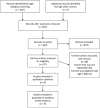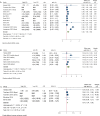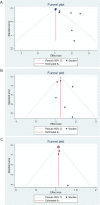Dose-response relationship between daily screen time and the risk of low back pain among children and adolescents: a meta-analysis of 57831 participants
- PMID: 37899211
- PMCID: PMC10613558
- DOI: 10.1265/ehpm.23-00177
Dose-response relationship between daily screen time and the risk of low back pain among children and adolescents: a meta-analysis of 57831 participants
Abstract
Background: The risk of low back pain (LBP) increases steeply during adolescence, and adolescents with LBP are more likely to have low back pain in their adult years. This study aimed to investigate the dose-response relationship between daily screen time and the risk of low back pain among children and adolescents.
Methods: PubMed, the Cochrane Library, Embase, and Web of Science were searched to collect relevant studies on daily screen time and the risk of low back pain from the establishment of the database up to December 2022. Two investigators independently screened the literature, extracted data, and evaluated the risk of bias in the included studies. Stata16.0 was used to perform a dose-response meta-analysis and the methodological quality evaluation of the included studies.
Results: The results of the meta-analysis showed that there is a positive correlation between daily computer time (OR = 1.32, 1.05-1.60), daily mobile phone time (OR = 1.32, 1.00-1.64), daily TV watching (OR = 1.07, 1.04-1.09) and the risk of low back pain, separately. The dose-response meta-analysis showed that there is a linear relationship between daily computer use and low back pain. The risk of low back pain increased by 8.2% for each 1-hour of daily computer use.
Conclusions: Screen time is related to the risk of low back pain, and there is a linear relationship between daily computer use and the risk of low back pain. A number of strategic measures should be taken to prevent adolescents from developing severe low back pain.
Keywords: Adolescent; Dose-response; Low back pain; Meta-analysis; Screen.
Conflict of interest statement
The authors declare that they have no competing interests.
Figures





Similar articles
-
Screen time and low back pain in children and adolescents: a systematic review of Brazilian studies.Rev Paul Pediatr. 2023 Apr 7;41:e2021342. doi: 10.1590/1984-0462/2023/41/2021342. eCollection 2023. Rev Paul Pediatr. 2023. PMID: 37042940 Free PMC article.
-
Non-steroidal anti-inflammatory drugs for acute low back pain.Cochrane Database Syst Rev. 2020 Apr 16;4(4):CD013581. doi: 10.1002/14651858.CD013581. Cochrane Database Syst Rev. 2020. PMID: 32297973 Free PMC article.
-
Low back and neck and shoulder pain in members and non-members of adolescents' sports clubs: the Finnish Health Promoting Sports Club (FHPSC) study.BMC Musculoskelet Disord. 2016 Jul 1;17:263. doi: 10.1186/s12891-016-1114-8. BMC Musculoskelet Disord. 2016. PMID: 27370945 Free PMC article.
-
[Relationship between low back pain and screen time among schoolchildren.].Rev Esp Salud Publica. 2021 Oct 13;95:e202110132. Rev Esp Salud Publica. 2021. PMID: 34643186 Spanish.
-
The natural course of low back pain from childhood to young adulthood - a systematic review.Chiropr Man Therap. 2019 Mar 20;27:10. doi: 10.1186/s12998-018-0231-x. eCollection 2019. Chiropr Man Therap. 2019. PMID: 30931103 Free PMC article.
Cited by
-
Associations of time spent on different types of digital media with self-rated general and mental health in Swedish adolescents.Sci Rep. 2025 Jan 6;15(1):993. doi: 10.1038/s41598-024-83951-x. Sci Rep. 2025. PMID: 39762280 Free PMC article.
-
Lifestyle Behaviors of Childhood and Adolescence: Contributing Factors, Health Consequences, and Potential Interventions.Am J Lifestyle Med. 2024 Apr 12:15598276241245941. doi: 10.1177/15598276241245941. Online ahead of print. Am J Lifestyle Med. 2024. PMID: 39554934 Free PMC article. Review.
-
Prevalence of musculoskeletal pain among undergraduate students.Front Med (Lausanne). 2024 Sep 20;11:1403267. doi: 10.3389/fmed.2024.1403267. eCollection 2024. Front Med (Lausanne). 2024. PMID: 39371343 Free PMC article.
References
-
- Dionne CE, et al. A consensus approach toward the standardization of back pain definitions for use in prevalence studies. Spine. 2008;33:95–103. - PubMed
-
- Hartvigsen J, et al. What low back pain is and why we need to pay attention. Lancet. 2018;391:2356–67. - PubMed
-
- Maher C, Underwood M, Buchbinder R. Non-specific low back pain. Lancet. 2017;389:736–47. - PubMed
-
- Plénet A, et al. Seeking care for lower back pain in the French population aged from 30 to 69: the results of the 2002–2003 Décennale Santé survey. Ann Phys Rehabil Med. 2010;53:224–31, 231–8. - PubMed
Publication types
MeSH terms
LinkOut - more resources
Full Text Sources
Miscellaneous

